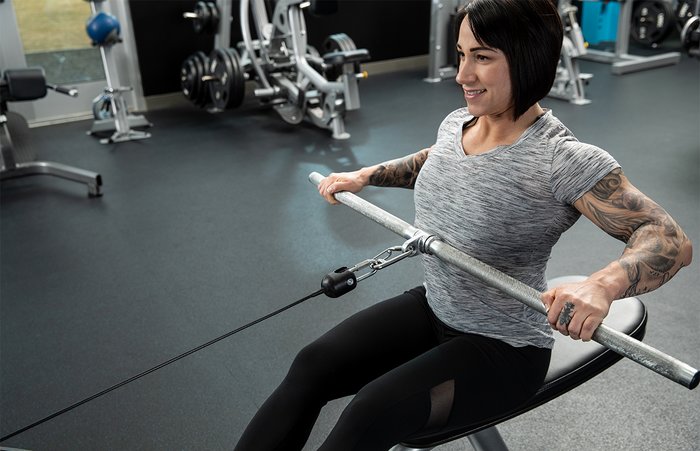For many people, just being "fit" isn't enough. Creating big beefy goals and chasing them for all you're worth is a timeless part of the fitness journey, and in the age of sharing (and over-sharing), it's more front and center than ever. And why not? There's something incredibly thrilling about seeing how far you can push your potential—crafting a very specific objective, keeping your blinders on, and ignoring what everyone else is doing in their own training while you focus on yours.
But what do you do when the goal…isn't the goal anymore?
Maybe you finally nailed that double- or triple-bodyweight deadlift, saw those abs in the mirror, or did that physique show or Spartan race. Great! Good for you. Or maybe you didn't, and you're just feeling injured/burned out/in need of a change. How do you say goodbye to this chapter that meant so much to you—or do you even have to?
Of course, you can just do a 180, switch to something completely different, and put your old chapter behind you. Plenty of people do! But you don't have to. Here are two potentially better ways to approach this common dilemma, with help from a world-class strongwoman and an elite personal trainer.

Method 1: Think in Seasons
Rachel Pyron has been competing in Strongwoman since 2011, but for a few years before that, she was a competitive bodybuilder. Over time, the dieting, the prep, the immense build-up to a single subjective judging all began to wear her down, and she realized she wanted a change. She wanted to feel strong!
The change has definitely paid off, seeing as she was named America's Strongest Woman in 2018. But initially, she struggled with the realization that taking up Strongman probably meant giving up the super-lean body she was used to.
"It was a challenge to switch mindsets from the bodybuilding world and channel all my focus on appearance and physique to strength and performance," Pyron says. "It was clear when I started strongman that the trisets and high-volume, quick burnout sessions were going to have to change. And the biggest changes, of course, were less dieting and more focus on building strength."
On the other hand, she also knew that her muscular base was part of what helped her succeed in strongman in the first place, and that pure hypertrophy work could have a legitimate place in her training.
The takeaway: Pyron gets the best of both worlds by thinking in terms of seasons. During the time of year when she competes, she focuses much more on the skills and conditioning that define her sport. Then, during the off-season, she incorporates much more lightweight bodybuilding-style training into her weekly schedule, and puts strongman on something close to "maintenance mode." This way, she gets to give her joints a break, maintain a muscular base, and avoid feeling beat up all the time. Plus, once competitive season rolls around, she's excited to dive back in.
You don't have to be a competitor to benefit from this approach, though. You could simply alternate styles of training during specific "blocks," focusing on muscular size part of the year, leaning out another part of the year, and chasing specific strength or athletic goals during a third part of the year. This is the approach Jim Stoppani, Ph.D., recommends in his video "Guide to Jim Stoppani's Training Programs." He advises doing Shortcut to Size, then Shortcut to Shred, then Shortcut to Strength. This allows you to experience the unique benefits of each style of training over and over again.
Method 2: Train with "Emphasis," Not Exclusivity
Many coaches and trainers have strict adherence to certain styles of training and methods of programming that they live and die by. They're a kettlebell coach, a powerlifting coach, a bodyweight coach, a… you name it. Nick Tumminello is no such coach.
He started training nearly 22 years ago at the age of 18 and has since then owned his own gym and worked with a wide variety of athletes, all while writing many articles and books about training. And a major part of his lasting power is that he hasn't aligned himself with any particular style of training. He takes what he can from all of them, and puts his own twist on whatever he learns.

"The way I look at it is, if I can use an analogy, the fact that people argue them against one another, to me, doesn't make sense, because all of them offer a different nutrient value if you look at them like foods," Tumminello says. "We agree that tomatoes are healthy, and we agree that some other vegetable is healthy, or fruit, but no one would ever agree that if you only ate strawberries you would have all the nutrients you need. Strawberries are deficient in nutrients that tomatoes may provide. It's the same with training styles."
Tumminello believes that each training style out there is actually complimentary to the others, not contradictory. For the everyday gym guy or gal, there is nothing wrong with having multiple goals. When it comes to addressing clients, he suggests that we simply have to evaluate what is the most important to us and understand that there will be give and take in other areas.
"Obviously goals are going to determine how much of one style may be a better fit for a situation. Most people also have secondary goals, and that's where other styles come in. It's just how much of which dials are turned up," he explains.
The takeaway: Struggling with balance? Here's how you can put Tumminello's "dials" into action:
- Be wary of coaches or other people preaching only one school of thought or style of programming. It's not that they're wrong, but it's easy to forget your own goals when you're listening to too many voices. You could end up leaving out many other important training principles that are proven to work in the long-run by just hopping on fitness trends that will eventually die out.
- Make sure that the training schedule, the times you train throughout the week, and types of exercises you decide on will be realistic for you to actually do. If you don't enjoy it, then you're unlikely to stick with it.
- Don't let anyone else set your goals for you! Take the time to really reflect on what you want and have an honest sit-down with your trainer. Ask the question, "Which is the most important of all of my goals? What comes second behind that?" This can change over time, so do it regularly.
- Look for ways to organize and prioritize goals, not eliminate them. You have the option of being well-rounded! Completely tossing out workout styles or exercises that you enjoy and would benefit from does you no good.
"There's no reason why you have to do just one thing. Figure out what your priorities are among the multi-dimensional programs, and from there just balance the volume out. Find the best way to do it, and stay consistent. Put more of whatever it is that's your main priority throughout the week," Tumminello says. "The more you do of something, the more likely you will achieve the goal. Obviously, there's an upper point to that, but it's individual. You achieve what you emphasize. Emphasizing one thing doesn't mean you neglect everything else."
Want to see what that approach looks like in action? Then try Tumminello's program True Muscle: 9 Weeks to Elite Fitness. It balances strength and muscle work with top-notch mobility and conditioning, giving you a well-rounded approach that you can use as a model for whatever comes next!

